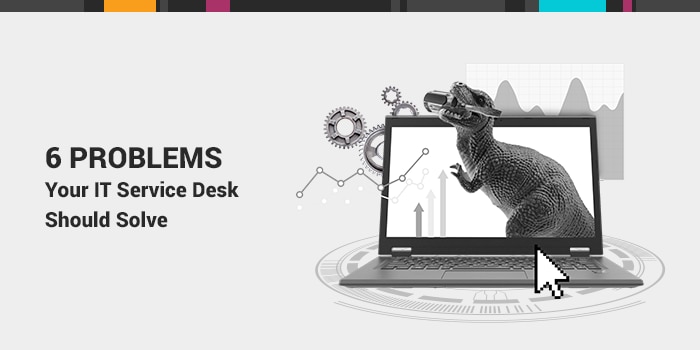Today’s organization can ill afford technology breakdowns or inefficient processes in IT. Because there’s such a heavy reliance on devices, applications, and other common business technology, the IT help desk bears a heavy burden in everyday business functions. Help desk personnel need every advantage they can find to improve service and speed up delivery.
Without a few essential ITSM best practices, the following IT help desk breakdowns can create major disruptions for any organization:
1. Walkups, phone calls, and emails
The support lines are flooded with calls. Employees are waiting on hold to speak to technicians, and some of them stop down to pay a visit in person. Ouch.
It’s difficult to prioritize tickets when they come in from all of these channels, and even harder to knock out resolutions with a ringing support line or a coworker at your desk describing an issue.
"Nobody likes to wait on a help line, but doctors and nurses particularly can’t afford to wait. It delays them when they’re trying to provide patient care. We wanted to get them another avenue to reach the help desk."
- Susan Bonville, Director of Customer Support and Operations, FirstHealth of the Carolinas
The solution for this is quite simple: give them a place to submit incidents that’s easy for them and organized for your help desk team. The
employee service portal is the best way to avoid the chaos of walkups, phone calls, and emails.
The transition from traditional request methods might hurt a little at first, but there are some creative ways to explain the benefits to employees and encourage them to
use the portal. In addition, you can always leave open the option of email submission; simply connect a support address to your service desk solution. But the more you can encourage submission through the portal, the fewer follow-ups you’ll need for more information and status updates.
2. Visibility/communication issues
After employees submit tickets or requests, how do they follow the status? If they have no idea where to look, there’s your first problem. When they don’t know, they call, email, and walk up all over again.
We’ve seen organizations with years of open tickets. We’ve heard too many stories of employees complaining that they don’t know when to expect resolutions.
That employee service portal will help here, too. Requesters should be able to track and filter any open ticket or request on the home screen in the portal. Anytime there’s been an update or a status change, they’ll receive a notification. If there’s a request for more information, they’ll receive a notification.
The other way to improve this visibility issue is to create an expectation that the service desk can meet. Attach a
service level agreement (SLA) to every type of service delivery – from incident resolution to complex service requests. When employees see the SLA, they can get back to work with the expectation that their requests will be delivered. No need to check in with a phone call.

hbspt.cta.load(41925, '5ac5565b-4805-49bd-acdf-254c674ab881', {});
3. Recurring incidents
The same tickets pile into your incident queues over, and over, and over again.
“The printer isn’t working.”
“I forgot my password.”
“My monitor won’t connect.”
“Blue screen of death.”
The obvious problem with solving the same incidents again and again is that it’s a waste of time. There are other things going on in the organization that require your help desk team’s problem solving skills.
The employee experience often suffers as well.
As one admin recently told us, “The first time someone asks you, it’s a three paragraph answer with screenshots and arrows. The second time, maybe it’s a little shorter, and no arrows. By the tenth time, you get a two sentence answer because I’m tired of typing it over and over.”
It’s human nature. The goal here is to give your team the tools it needs to provide the best possible experience for requesters. This is where the
knowledge base comes into play. First off, that three paragraph answer with screenshots and arrows can be converted to a reusable knowledge article. Now, your entire staff can simply forward the link to a solution for a repetitive issue.
Even better, you can make these articles available to requesters through the employee service portal. Machine learning can even suggest articles as they type in their incidents, which will catch a lot of potential tickets before they ever even hit the
help desk.
4. Losing Track of Assets
Phones, laptops, and other devices are everywhere in the modern organization. All types of work environments – from
schools to
hospitals to
financial institutions – rely on technology in some form to keep the wheels turning. In fact, there are so many of these devices that it’s impossible to keep track of them all without an organized approach that includes discovery and full lifecycle evaluation.
If you implement an
IT asset management strategy, you can take advantage of two major benefits to your organization.
First, you’ll always be prepared for the financial impact of technology in the organization. You’ll know where the assets are, which ones need updates, which devices are using a software or application license, and a number of other consequential details. You’ll never have to ask an employee a question about what type of laptop they have or if they currently use a software license.
Second, it’s an easy way to improve internal service. You can track incidents per device, find connections between assets, anticipate how maintenance will impact different employees, and automatically update groups impacted by changes and releases.
Limiting these types of breakdowns can help an organization in service delivery, but also in larger business goals that affect the bottom line. Solve these four common issues in the
IT help desk, and you’ll be on your way to incredible efficiency in all areas of employee service.
 hbspt.cta.load(41925, '5ac5565b-4805-49bd-acdf-254c674ab881', {});
hbspt.cta.load(41925, '5ac5565b-4805-49bd-acdf-254c674ab881', {});




